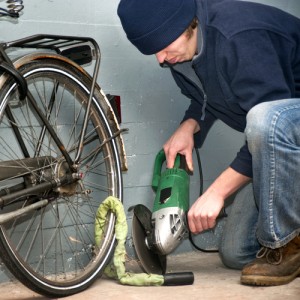Outthink the Thieves: Best Practices for Deterring Theft of Your Bike
Written by: Ken Selander Category: Bicycle Accidents, Safety With the increasing popularity of bicycling as a means of transportation – more bikes are out and about and that means more targets for thieves. With an estimated 250,000 bikes stolen each year, how can you best ensure that your bike won’t become a statistic? The answer: proper documentation and locking technique.
With the increasing popularity of bicycling as a means of transportation – more bikes are out and about and that means more targets for thieves. With an estimated 250,000 bikes stolen each year, how can you best ensure that your bike won’t become a statistic? The answer: proper documentation and locking technique.
If your bike is stolen, you must first prove that it was yours. Always record your bike’s serial number (usually found under the bottom bracket), take a photo of it, and keep the information in your files. Better yet, register your bike with the National Bike Registry or Bike Shepherd.org. Both organizations will provide you with tamper resistant labels, services to help you recover your bike should it get stolen, and may help prevent it from being sold at a bike shop.
If you have homeowners or renters insurance, make sure your bike is covered under the policy – a small comfort to know that you could recoup some money to replace your bike if it never gets recovered.
Now that your bike is documented or registered somewhere (either in an online database or your file drawer), properly lock your bike to make it an unattractive target to thieves. Ideally, you want your bike to be too much of a hassle to steal and too easily identifiable. Write your name in sharpie on the top tube and cover it with several layers of clear packing tape. Any sort of identifying marks or features (crazy bar tape or stickers) can serve as a deterrent to thieves.
The best option for a lock is a heavy chain or a hardened steel U-Lock. Use the smallest U-Lock possible: the smaller or tighter the lock up, the more difficult it will be for a thief to insert a pry bar to break the lock. And by all means, do not use a small chain or a cable lock – these are easily and quickly cut.
Don’t lock your bike from the top tube – a thief can then use your entire frame as leverage to break the lock. When using a U-Lock, be sure to face the keyhole down towards the ground, making it harder for a thief to pick the lock quickly. Anything that requires a would-be thief to spend more time at your bike is a good thing – it makes their attempt far more conspicuous (not to mention frustrating) and they’ll move on to another, easier target.
When locking your bike, keep in mind that bikes can be lifted over parking meters and small trees; chain link fences and aluminum poles are also easily cut. Take the time to find a well-lit area and lock your bike to a fixed, immovable object or, better yet, a dedicated bike rack. Keep in mind though that locking your bike to stairwells and hand-railings is bad bike etiquette and may violate Washington fire codes. Never lock your bike where it is going to obstruct someone’s path.
Also, you should never leave your bike unlocked, not even “for just a minute”. A thief is looking for a quick steal, so while you’re in the coffee shop grabbing a quick cup, the bike you left on the sidewalk leaning against a tree could be blocks away by the time you take your first sip. Don’t make it easy – always, always lock your bike.
Lastly, take any accessories with you – lights, tool bags, pumps. If they are easily removable items and you don’t take them with you, someone else will. This includes your seat if you have a quick release seat! If you’d rather not take your seat with you, replace the quick release with a seat binder bolt. Similarly, securing your wheels with a locking skewer is always a good idea for added protection.
Just remember – the key to locking your bike properly is to buy time. Nothing is iron-clad, but hopefully, you can make stealing your bike (and its parts) as difficult as possible.

